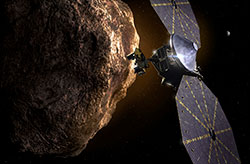NASA’s Lucy Mission to Observe Jupiter’s Trojan Asteroid Swarms Written 29 September 2021

Depiction of NASA's Lucy mission. | NASA
CNN reports that the Lucy mission, the first NASA mission to study Jupiter’s Trojan asteroid swarms, “has passed all of its prelaunch tests and is set to leave Cape Canaveral Space Force Station at around 5:30 a.m. ET on October 16.” These asteroids “are remnants from the early days of our solar system” and “the mission will help researchers effectively peer back in time to learn how the solar system formed 4.5 billion years ago.” Tom Statler, Lucy project scientist at NASA Headquarters, said: “With Lucy, we’re going to eight never-before-seen asteroids in 12 years with a single spacecraft. This is a fantastic opportunity for discovery as we probe into our solar system’s distant past.” CNN reports that “the Lucy spacecraft is more than 46 feet (14 meters) from tip to tip, largely due to its giant solar panels – each about the width of a school bus – designed to keep up a power supply to the spacecraft’s instruments.”
Full Story (CNN)
